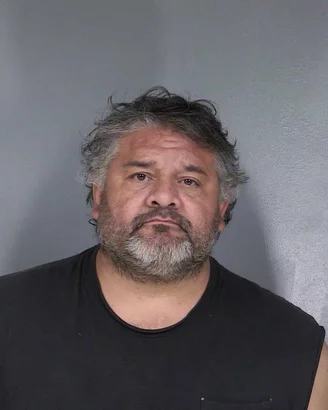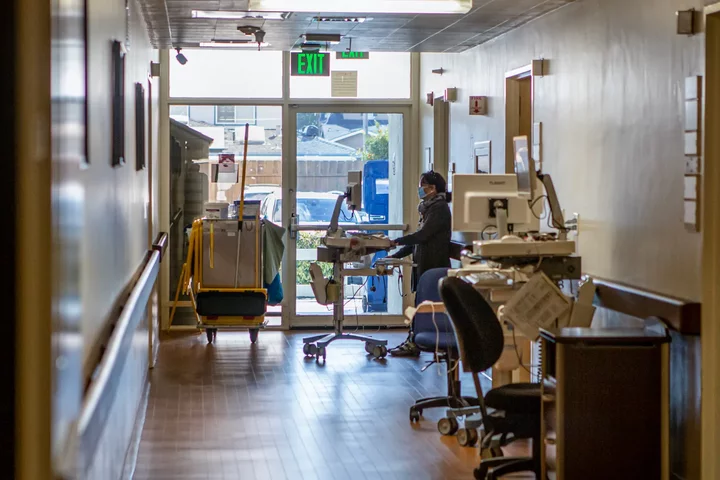HUMBOLDT TODAY with John Kennedy O’Connor | April 25, 2023
LoCO Staff / Tuesday, April 25, 2023 @ 5:04 p.m. / Humboldt Today
HUMBOLDT TODAY: Bodycam footage shows a local detective successfully performing CPR on an infant; a large local cannabis farm is liquidating its assets; plus, we’re sprucing up Arcata’s Redwood Park! Those stories and more in today’s online newscast with John Kennedy O’Connor.
FURTHER READING:
- Stolen Gun, Illegal Drugs and Burglary Tool Found During McK Traffic Stop, Sheriff’s Office Says
- Motorcycle Chase Near Hoopa Results in Meth Arrest and Also the Discovery That the Motorcycle Was Stolen, Sheriff’s Office Says
- Body Cam Footage Shows Sheriff’s Detective Saving an Infant’s Life by Administering CPR
- Several Days of Sunshine and Warmth are Forecast for Humboldt County, and We’ve Sure as Hell Earned Them
HUMBOLDT TODAY can be viewed on LoCO’s homepage each night starting at 6 p.m.
Want to LISTEN to HUMBOLDT TODAY? Subscribe to the podcast version here.
BOOKED
Today: 3 felonies, 10 misdemeanors, 0 infractions
JUDGED
Humboldt County Superior Court Calendar: Today
CHP REPORTS
7166 David Ave (HM office): Traffic Hazard
Sr299 / Glen Rd (RD office): Assist CT with Maintenance
ELSEWHERE
RHBB: Prescribed Burning Planned Today Across Multiple Green Diamond Sites, Weather Permitting
Humboldt Last Week: 367: CBS drama, Guy Fieri’s quad “explodes,” supervisor clash, hate-crime chaos?, store closures, NFL dudes, and more
County of Humboldt Meetings: Fish & Game Advisory Commission Agenda - Regular Meeting
CALLING ALL ARTISTS! There’s a New Arts Festival Coming to Eureka and the City’s Providing More than $40K in Grant Funding for Cool Projects
Stephanie McGeary / Tuesday, April 25, 2023 @ 4:47 p.m. / Art , Event
The Parade of Dreams on the Waterfront in August 2022 | Photo: Matt Filar
###
Have you always dreamed of creating a giant, interactive art installation in Eureka? Or maybe you have a vision for a performance art piece or an extravagant costume, but you just don’t have the means to execute it? Well, now is the to make your art dream come true, because there’s a new festival coming to town and the City of Eureka is giving away lots o’ grant money to fund your wacky project.
The newly created event is called Festival of Dreams – a collaboration between the North Coast Repertory Theatre (NCRT), Ink People Center for the Arts and the City of Eureka. The festival will happen in two parts: an outdoor event Aug. 18 through 20 that will take place at Halvorsen Park and around Old Town, and an indoor festival on Oct. 5 through 8, that will be held throughout multiple different Eureka venues. And to make this new festival even more exciting, the City has made more than $40,000 in American Rescue Plan Act (ARPA) grant money available to fund local artists who want to participate.
“We’re excited to create a festival that has mystery and playfulness to it,” Calder Johnson, artistic managing director for NCRT, told the Outpost. “We want to promote the idea that art is something to be explored, played with and experienced, rather than just observed.”
Johnson said that he and Leslie Castellano, Eureka City Council member and executive director of the Ink People, have both wanted to hold some kind of interactive art festival here for years. The Ink People and NCRT collaborated on an event last summer called the Parade of Dreams, where community members were invited to dress up in costumes inspired by their dreams. The festival is based on the same idea of people making their dreams come to life, Johnson said, which is why they chose the name Festival of Dreams. The event will also kick off with another parade, which will take place in Old Town on Friday, Aug. 18.
Johnson said he and Castellano were also inspired by interactive art spaces in other cities, particularly Meow Wolf — an immersive art and entertainment space built out of an abandoned bowling alley in Santa Fe. Johnson thinks Meow Wolf is a great example of how artists can really utilize space and how the public can experience art in an unexpected way. “It’s like Burning Man meets the Exploratorium,” Johnson said.
The Festival of Dreams will accept a variety of art projects — including large-scale outdoor art installations, smaller installations, performance art, music and even costumes for the parade — and grant awards range anywhere from $100 to $4,000 per project. Applicants are also encouraged to partner with local businesses to create art and events inside different businesses, including window displays, performances inside or outside the business, music shows and after parties. These grants will require matching funds from the venue or business owner.
The theme for the inaugural festival is “Secrets of Wigi,” and will center around the beauty and resources provided by Humboldt Bay (Wigi). Johnson said that it’s a loose theme, meant to serve as inspiration for the artists and that submissions do not necessarily have to reflect the theme.
Johnson said the organizers will respond to people’s submissions as quickly as possible to let them know if they have been approved, if the organizers have questions or suggestions on how to make the project work within the confines of the festival and the grant budget. Johnson also wanted to mention that the organizers strongly encourage applications from BIPOC, LGBTQIA2S+ and youth artists.
Once the submissions have been selected, there will be an artist meeting on June 2 to help guide the creation process. There will also be other meetings and festival announcements between now and August, so stay tuned. Since announcing the festival and grant availability on Monday, Johnson said he has received a lot of positive community feedback and multiple applications have already come in. As the word spreads and the deadline nears, he can’t wait to see what other ideas people cook up for the festival.
“I’m excited to see what people come up with,” Johnson said. “It’s just going to be a loving celebration of expression and creativity.”
You can find more info, check out the proposal guidelines and submit your grant application here. The application deadline is May 19.
Stolen Gun, Illegal Drugs and Burglary Tool Found During McK Traffic Stop, Sheriff’s Office Says
LoCO Staff / Tuesday, April 25, 2023 @ 11:31 a.m. / Crime
Goodwin (left) and McKenney.
Press release from the Humboldt County Sheriff’s Office:
On April 24, 2023, at about 11:11 p.m., Humboldt County Sheriff’s deputies on patrol in the McKinleyville area conducted a traffic stop for a vehicle code violation in the area of Central Avenue and Norton Road.
Deputies contacted two occupants of the vehicle, the driver, 34-year-old Vincent Charles McKenney and passenger 31-year-old Tyler Shane Goodwin. Deputies learned that McKenney was driving with an expired license and was on formal probation. Deputies conducted a search of the vehicle pursuant to the terms of McKenney’s probation. During a search of the vehicle, deputies located an unsecured loaded, stolen firearm, approximately 1.2 grams of methamphetamine and drug paraphernalia.
Based upon deputies’ investigation, the firearm was determined to have been in Goodwin’s possession. During a search of Goodwin incident to arrest, deputies located shaved keys and a small amount of suspected fentanyl.
McKenney was arrested and booked into the Humboldt County Correctional Facility on charges of possession of a controlled substance (HS 11377(a)), possession of a controlled substance paraphernalia (HS 11364(a)), violation of probation (PC 1203.2(a)(2)) and driving without a license (VC 12500(a)).
Goodwin was arrested and booked into the Humboldt County Correctional Facility on charges of carrying a concealed weapon in a vehicle (PC 25400(a)(1)), felon in possession of a firearm (PC 29800(a)(1)), carrying a loaded firearm in a public place (PC 25850(a)), possession of stolen property (PC 496(a)), possession of a controlled substance while armed (HS 11370.1(a)) and possession of burglary tools (PC 466).
Anyone with information about this case or related criminal activity is encouraged to call the Humboldt County Sheriff’s Office at (707) 445-7251 or the Sheriff’s Office Crime Tip line at (707) 268-2539.
Motorcycle Chase Near Hoopa Results in Meth Arrest and Also the Discovery That the Motorcycle Was Stolen, Sheriff’s Office Says
LoCO Staff / Tuesday, April 25, 2023 @ 10:53 a.m. / Crime
Press release from the Humboldt County Sheriff’s Office:
On April 24, 2023, at about 7:04 p.m., Humboldt County Sheriff’s deputies on patrol in the Hoopa area attempted to conduct a traffic stop on a motorcycle in the area of Highway 96 near Big Hill Road. The motorcycle failed to yield, and a pursuit ensued.
Deputies pursued the motorcycle for approximately 1.5 miles. The driver, 51-year-old Clifford Dale Houston, yielded to deputies on Mill Creek Road and was taken into custody without further incident. During a search of Houston incident to arrest, deputies located approximately 1 gram of methamphetamine. Additionally, during their investigation, deputies learned that the motorcycle had been reported stolen out of Eureka.
Houston was arrested and booked into the Humboldt County Correctional Facility on charges of possession of a stolen vehicle (PC 496d(a)), flight from a traffic officer (VC 2800.1(a)), possession of a controlled substance (HS 11377(a)) and driving with a suspended license (VC 14601.1(a)) in addition to warrant charges of failure to provide evidence of financial responsibility (VC 16028(a)) and driving with a suspended license – prior conviction (VC 14601.2(a)).
Anyone with information about this case or related criminal activity is encouraged to call the Humboldt County Sheriff’s Office at (707) 445-7251 or the Sheriff’s Office Crime Tip line at (707) 268-2539.
Body Cam Footage Shows Sheriff’s Detective Saving an Infant’s Life by Administering CPR
LoCO Staff / Tuesday, April 25, 2023 @ 9:56 a.m. / News
From the Humboldt County Sheriff’s Office’s social media pages:
On April 13, an HCSO detective and deputy were working a special assignment in the Eureka area when they saw a call for service regarding a four-week-old infant not breathing at a nearby residence.
The deputies responded immediately. HCSO Detective Nick Carnahan was first into the residence and began performing CPR on the infant until she was able to breathe again. It was later determined that the infant had aspirated and that Detective Carnahan’s quick actions saved the infant’s life.
This entire incident was captured via the responding deputy’s body worn camera. We are sharing it today with the permission of the family.
In the United States, choking is one of the leading causes of injury and death in children, causing the death of one child every five days. First Aid and CPR saves lives. Find out what to do during a choking emergency at: https://www.stanfordchildrens.org/en/topic/default…, or find a class near you to become CPR Certified.
Several Days of Sunshine and Warmth are Forecast for Humboldt County, and We’ve Sure as Hell Earned Them
Hank Sims / Tuesday, April 25, 2023 @ 8:22 a.m. / How ‘Bout That Weather
Ol’ Mr. Sun. Photo by Rajiv Bajaj on Unsplash
###
Rain is a wonderful thing for the plants and animals of the forest, especially after three straight years of drought, but it can be tough down here on the human level. Maybe your experience differs, but in this reporter’s circles people’s behaviors are more and more resembling Jack Nicholson’s, about two-thirds of the way through The Shining.
Here we are nearing the end of April — about halfway through the October-September rain calendar — and we’re sitting pretty at 40 inches of rainfall in Eureka, the first time in ages and ages that we’re actually well ahead of what we used to think of as a “normal” amount of precipitation.
So this is a great time for a little break, and it looks like we’re going to get it! The sun is forecast to shine brightly throughout the next seven days, and we’re even due for a little mini-heatwave on Wednesday, Thursday and Friday. Temperatures on the coast are gonna climb into the 70s, and in the inland areas they could spike all the way into the 90s!
After that: More sun, but chillier.
Here’s how our friends at the National Weather Service office on Woodley Island phrase it, in this morning’s Area Forecast Discussion:
SYNOPSIS…A warming trend will occur across Northwest California through mid week, with interior valley high temperatures climbing into the 80s and ranging to the 60s and 70s along the immediate coast. Thereafter, cooler temperatures along with showers and thunderstorms will become more probable this weekend into early next week.
Eat, drink, be merry. Enjoy the sunshine while it lasts.
Graphic: National Weather Service, Eureka.
California’s Lowest Paid Health Workers Want a Pay Boost. Why Industry Leaders Are Pushing Back
Ana B. Ibarra / Tuesday, April 25, 2023 @ 7:25 a.m. / Sacramento
A medical personnel working on her computer in the corridor of Hazel Hawkins Memorial Hospital in Hollister on March 30, 2023. Photo by Larry Valenzuela, CalMatters/CatchLight Local
Supporters of a proposal to raise the minimum wage for California health workers point to Inglewood, where last fall voters approved a wage hike that primarily applied to staff at dialysis clinics and at the city’s only hospital. But the implementation of that local measure has been bumpy, signaling potential problems for the larger effort.
Inglewood’s ordinance went into effect Jan.1, raising the minimum wage for those workers to $25 an hour. Then in March, Centinela Hospital Medical Center, a 362-bed acute care facility owned by Prime Health Care, laid off 48 workers and reduced hours for others, according to a complaint filed earlier this month by the Service Employees International Union-United Healthcare Workers West. The union led Inglewood’s measure and is sponsoring the statewide bill.
The union alleges hospital administrators made the cuts in retaliation to the newly implemented wage increase, even though the city ordinance prohibits health facilities from funding the pay increase by laying workers off or reducing their benefits.
Centinela officials maintain that the hospital is complying with Inglewood’s minimum wage ordinance. They say they laid off workers after a thorough assessment that determined the hospital was overstaffed in certain units. Centinela offered nearly half of the affected staff other positions within the hospital and many accepted, according to a hospital spokesperson.
“The recent reduction in force was entirely unrelated to the ordinance and affected 2% of the staff,” Susan Lowe, Centinela’s spokesperson, said in an email. “It was related to strategic changes in operational needs and improvement measures, and staff have been added in areas that positively impact patient care and address community needs.”
While the lawsuit is pending, the union is advocating for a broader pay hike for California health workers via Senate Bill 525, by Los Angeles Democratic Sen. Maria Elena Durazo, a longtime labor leader. Durazo’s bill calls for a minimum hourly wage of $25 that would be adjusted annually for inflation. California’s minimum wage is currently $15.50, although it’s higher in some cities and counties.
“It’s not asking for the moon, this is just the baseline of a fair wage for the people who provide vital treatment.”
— Renee Saldaña, spokesperson for SEIU-UHW
If the proposal becomes law, the new minimum wage would go into effect in January 2024 and benefit an estimated 469,000 health workers. It would include people who make slightly more than $25, who would likely get a corresponding pay increase, according to an analysis by UC Berkeley’s Labor Center.
Qualifying workers would receive an average increase of $5.74 per hour, which would increase operating costs at health facilities by about 3%, the report said. Some lower paid workers in health facilities include nursing assistants, patient aides, medical technicians and janitorial workers.
The proposal faces a great deal of opposition from industry heavy hitters, including hospital executives, clinic leaders and the doctors’ lobby, which argue this isn’t something all providers can afford or easily implement, especially when they’re dealing with other stressors in their budgets. The California Chamber of Commerce lists the bill as a “job killer.”
But union leaders say the time is now, especially as the industry grapples with workforce shortages that are burning out current staff. “Twenty-five dollars an hour breaks down to roughly $50,000 a year,” said Renee Saldaña, a spokesperson for SEIU-UHW. “It’s not asking for the moon, this is just the baseline of a fair wage for the people who provide vital treatment.”
Who would benefit
Eneryk Santana last month joined the tens of thousands of people who commute daily across the San Diego-Tijuana border for work or school. He’s a medical assistant at San Ysidro Health Center in Chula Vista and the high cost of living on the U.S. side, he said, forced him to look for housing in Mexico.
To avoid rush hour traffic at the border crossing, he tries to leave his place by 4 a.m. While the border cities are less than 20 miles apart, the process of crossing the border can take up to a few hours on busy days. The commute has been an adjustment, but he said his monthly rent in Tijuana is about $1,000 less than what he was paying in Chula Vista — a significant difference for someone making $22 an hour.
For Santana, a boost in pay would allow him to consider moving back to the U.S., he said. Ideally it could also mean more people attracted to this type of work. “Being short-staffed, when someone calls off, we don’t have much staff who can cover,” Santana said. “And it’s hard not only for workers, but also for the patients, who sometimes have long wait times.”
Workers in clinics and hospitals account for about half of all workers who would see a boost in pay under Durazo’s bill, according to the analysis from UC Berkeley’s Labor Center. Because of their current low earnings, workers in home health services and nursing homes would see the biggest difference — approximately a 40% increase.
Three-fourths of the workforce who would receive a raise under the bill are women, and almost half are Latino, according to the report.
The fight against industry
Hospitals are leading the opposition to the wage hike, arguing that some facilities are in precarious financial situations. A handful of hospitals in the state have reduced or plan to reduce services. Last week a Montebello hospital filed for bankruptcy and a hospital in the San Joaquin Valley closed its doors at the beginning of this year.
Having to boost minimum wage pay, hospital leaders say, would only add to that strain. A wage hike at this time “takes a very serious problem and makes it impossible,” Carmela Coyle, president of the California Hospital Association, recently said in a call with reporters.
Punctuating its point, the hospital association released a report earlier this month that found that 1 in 5 hospitals are in an “unsustainable financial position” and at risk of closing. Hospitals are considered at-risk if their incomes aren’t covering costs, meaning they are losing money, and have increasing debt, said the report, which sampled 114 hospitals.
Union leaders have pushed back on hospitals’ arguments, noting that most hospitals are part of large health systems that can weather rough patches.
A wage hike at this time “takes a very serious problem and makes it impossible.”
— Carmela Coyle, president of the California Hospital Association
Health economists have described the current landscape of California hospitals as a mixed bag with independent and rural hospitals, especially, experiencing severe financial pressures.
During the peak of the pandemic, hospitals had increased expenses, but also received financial aid from the federal government. That funding phased out in 2022. The state has not yet audited totals for this last fiscal year, but in 2021, altogether California hospitals posted earnings of $11.9 billion, up from the $8.5 billion hospitals recorded in 2019, according to financial data from the Department of Health Care Access and Information.
A coalition of counties has also voiced its opposition to the bill, noting the bill would apply to workers at county public health and mental health departments, as well as clinics and hospitals operated by counties.
Implementing such a bill would cost the counties hundreds of millions of dollars annually, said Kalyn Dean, a legislative advocate with the California State Association of Counties. To absorb that cost, she said, counties could be forced to reduce services and cut jobs in other government departments.
Meanwhile, clinic leaders say that while they support the idea of boosting pay for their workers, they are subject to strict reimbursement rules that do not allow them to take on the additional expense. The vast majority of community health centers’ patients are covered by Medi-Cal, the health insurance program for low-income people. Medi-Cal pays these centers a fixed amount per patient visit. Modifying that amount to afford a wage increase would require both state and federal approval, said Dennis Cuevas-Romero, vice president of government affairs at the California Primary Care Association, which represents health centers.
“Unlike other businesses, we can’t just say, ‘OK, the state requires us to increase the minimum wage, let’s just increase the cost of our services.’ We are prohibited from doing so,” he said.
Some provider groups are likely to seek an exemption from this bill, but community health centers say they would like to find a way to make this work because a “nightmare” scenario would be for their clinic employees to leave for better-paying jobs at a nearby hospital.
“Our health centers want to get there,” Cuevas-Romero said. “I think the questions are: Where’s the money coming from? And how do we implement it?”
###
CalMatters.org is a nonprofit, nonpartisan media venture explaining California policies and politics.






